|
Itronix Factory Tour
Visiting Itronix, now a General Dynamics Company
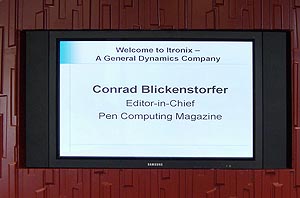 Itronix had invited me up to their Spokane, WA, headquarters so I could get an idea where this longtime leader in rugged computing and wireless systems was headed after their acquisition by General Dynamics in September of 2005. Itronix had invited me up to their Spokane, WA, headquarters so I could get an idea where this longtime leader in rugged computing and wireless systems was headed after their acquisition by General Dynamics in September of 2005.
So on May 17, 2006, I flew up from Sacramento in an Alaska Airlines's Horizon turbo-prop plane, stopping in Boise, Idaho which, interestingly, is in a different time zone. My old friend Matt Gerber, newly promoted to Vice President of Sales and Marketing, picked me up at the airport and we exchanged our latest automotive adventures (we're both car nuts). I checked in at the historic Davenport Hotel in downtown Spokane, a beautifully restored old AAA four diamond hotel with ballrooms and all sorts of historic touches and decorations that are just wonderful. Those visiting Spokane should stay there.
To reacquaint myself with some of my old contacts at Itronix before the following day's factory tour, we had arranged dinner at the Bluefish Japanese restaurant just across the street from the Davenport. Present were Matt Gerber, Marie Hartis who is director of worldwide marketing communications, Brian Fiut who is a product manager, and myself. The food was delicious, with Matt proving to be quite the expert in ordering Japanese fare. So we ended up with a huge sushi platter and more. The conversation was informative, yet lighthearted and cordial, and I certainly did not get the impression that these were employees of a company filled with trepidation, one that doesn't quite know what to expect from its new owners. Matt explained that Itronix would continue to sell to commercial markets, but that the split would now favor government whereas before the majority of sales had come from commercial accounts.
I learned that Sprint had ordered some 3,000 of the semi-rugged GoBook VR-1s to replace their older Itronix GoBook computers -- certainly a big coup. Tom Turner, president and CEO of Itronix, now also holds the title of Vice President & General Manager of the Computing Technologies Division within General Dynamics' C4 Systems that Itronix has become part of. I wondered about the ramifications of keeping or changing the well-established Itronix brand name and identity. I was told that the idea of changing the Itronix name was not imposed on the company; rather it was something that was suggested and agreed on by all involved.
I also learned that Itronix is now located in a brand new facility that they planned and designed from scratch to fit their needs. The two facilities Itronix had used prior had been leased, and so the transition was easy. Gerber said the new manufacturing floor was smaller but, due to much improved efficiency, manages to produce more units. Those productivity gains would be demonstrated to me impressively the next day.
The next morning, Marie Hartis met me at 7:30AM at the Davenport where we had breakfast and I learned more about the recent developments at Itronix. Then we were headed for the new Itronix facilities at 12825 Mirabeau Parkway in Spokane Valley, Washington (see front entrance below).
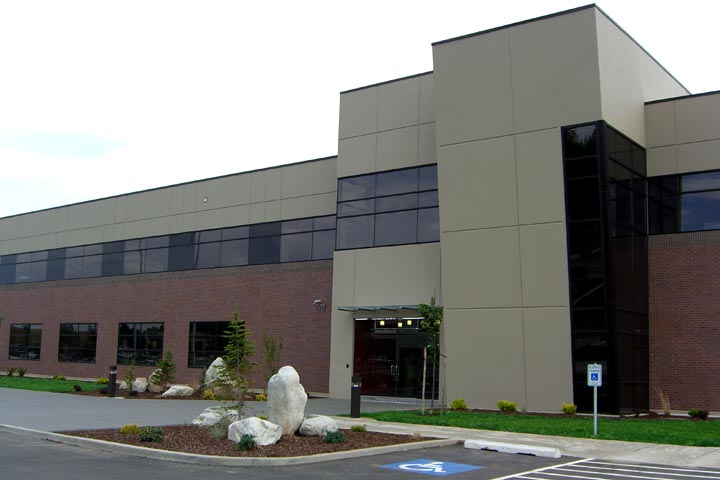
Branding transition to being a General Dynamics Company
At the impressive new building just outside of Spokane, Matt Gerber provided a high-level overview of General Dynamics, the brand transition strategy, and product line updates and futures. The brand transition is well underway, but it will take until the end of 2006 for it to be completed. For now, Itronix represents itself as General Dynamics in the defense sector, but still as "Itronix, a General Dynamic Company" for the commercial sector. General Dynamics itself, headquartered in Falls Church, Va., had US$21.2 billion revenues in 2005. The company consists of four major units, those being Combat Systems, Aerospace (which includes Gulfstream), Marine Systems, and Information Systems and Technology which includes C4 Systems and handles GD's information technology side. Information Systems and Technology alone is a US$8 billion entity.
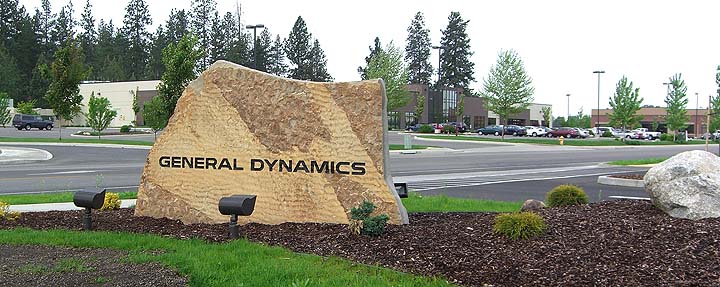
C4 Systems itself is an integrator of secure communication and information systems and technology, has seven groups, and represents about $3 billion in annual sales. Among them are Battle Management, Communications Network (hard core radio technology), Information Assurance (secure products), Space and National Systems, GD Canada (office systems), SATCOM Technologies (satellite base stations) and the Computing Technologies Division, with headquarters in Spokane.
Computing Technologies consists of Itronix, Tadpole which was acquired in August of 2005 and is now part of Itronix, and Commercial Hardware Systems. The latter produces V1 and V2 versions of notebooks. "V1" means a product is standard, "V2" means it has been hardened to meet special ruggedness and other requirements.
Itronix's new motto is "Mission Critical Computing on the Move." The old motto had essentially been that "we're best in class, and we can help through the entire process, all under one roof." The focus was on being one-stop shop. There is a different positioning now that the company is part of General Dynamics, a much larger organization that has a much broader reach, and the "Mission Critical Computing on the Move" better describes the overall abilities and offerings. Matt Gerber says, "For anything mission critical that is mobile, the likelihood is we have a product for it. The new buzz words are comprehensive, connected, core-to-edge." This refers to the ability to offer technologies that get from the core of a company to the very edge.
All of this is applicable for governmental (primarily military) and for commercial applications--two very distinctive flavors.
Gerber then showed a series of slides with the various product lines.
Thin Clients
Thanks to the addition of Tadpole, Itronix now has a line of thin clients based on Sun Microsystems' Sunray technology. Those are marketed under the Tadpole name and include the Comet 12 (standard), the Comet 15 and the V2 Comet 15. The application for those devices is primarily in military IT, as wireless bedside terminals in healthcare applications, and for data sharing. Sophisticated SmartCard user authentication makes these lightweight devices secure. They are also immune to viruses, data theft, and can greatly reduce IT administration costs.
Windows Clients
Windows clients have long been Itronix's primary business. Those include the GoBooks (GoBook Duo-Touch, GoBook VR-1, GoBook III), a special V2 Dell 810 CHS-3 Rugged notebook, the Ndura Tempest tablet which is based on DuoTouch guts and designed for military use. I was also given a detailed preview of the GoBook XR-1 which at the time had not been announced yet. The XR-1 would become the first Itronix product to carry the General Dynamics brand name.
UNIX Clients
Itronix offers a series of industrial strength Unix Clients geared primarily towards tactical military use where relatively lightweight laptops can replace large and heavy UNIX servers. The core product there is the Solaris-based Viper Laptop, the V2 Bullfrog I, the V2 Unix Laptop, and the V2 TCU rackmount. Bullfrogs can control Phalanx machine gun system.
Mobile Clients
Mobile Clients include a variety of small form factor devices. Some, like the Q200, are used for meter reading, field service, and such. Others have military applications. The Land Warrior Core Computer integrates functionality into one very rugged, very compact box. The L-Band/SAASM GPS Tablet looks like a tiny Tablet PC. Joining the lineup will be the Hand Held Product Dolphin 7900.
Mobile Servers
The Bullfrog 2 is a large heavy-duty server notebook with dual 1.2GHz UltraSPARC III processors, a 17-inch screen, full length PCI slots and do on, but they also have rugged mobile servers that look more like rack-mount systems.
Wireless Options
There is a huge number of wireless options for Commercial and Defense application, with just a bit of overlap in multi-mode networking.
Commercial systems include WANs (GSM/GPRS/EDGE, HSPDA, UMTS/WCDMA, and CDMA EVDO), Metropolitan Area Networks (802.16a Wi-MAX), LANs (802.11a/b/g and 802.11i WPA2), as well as Bluetooth. Defense systems include Tactical Over the Horizon, Tactical Line of Sight, Tactical Sensor Networks, and regular intercoms.
Gerber mentioned that there was definitely a learning curve to get up to speed with all the military-specific systems with their heavy use of acronyms -- in fact, 36 pages of them.
Core-to-Edge Integration
Core-to-Edge integration systems refer to Itronix's comprehensive approach that includes assessment, design, integration, deployment, and then operation, all with global support, even in unfriendly places where people generally do not want to go. There are six in the United States, four in Europe, operations in Korea, Iraq, etc., and many more.
I saw the large customers list that includes some impressive names, like Sears, Sprint, Coca Cola, T-Mobile, FedEx, Caterpillar, Geico, Verizon, PG&E and so on. Very substantial also is the list of alliances.
Whenever a company is acquired, there is a chance that cultures clash, brain drain happens, or the acquired company simply gets absorbed or closed down. Not so in this case, said Gerber. They have experienced very little territorialism and he gave as the reason the fact that General Dynamics has a long history of acquisitions. As a result they have a structure and culture that is used to integrating new companies on a friendly basis. Gerber did mention one little "culture shock" when the General Dynamics audit teams arrived to take a look at their new acquisition. Whereas most other GD facilities don't even have wireless networks because they are not secure enough, Itronix has plenty of them, all as secure as they get in commercial operations. The GD auditors decreed that Itronix can continue to use them.
Obviously, the acquisition does mean substantial education and training in many parts of the organization. The sales force needs to be educated of new opportunities, new products, and all the many new resources available within General Dynamics.
Shopfloor tour
While some competitors simply rebadge generic computers and handhelds made in Taiwan or mainland China, Itronix designs almost all aspects of their computers and then works with a small number of top-notch ODMs in Taiwan and the United States. All parts, components and peripherals then arrive at Itronix's assembly floor in the Spokane facility. The facility both assembles new machines per customer specifications as well as services and rebuilds computers.
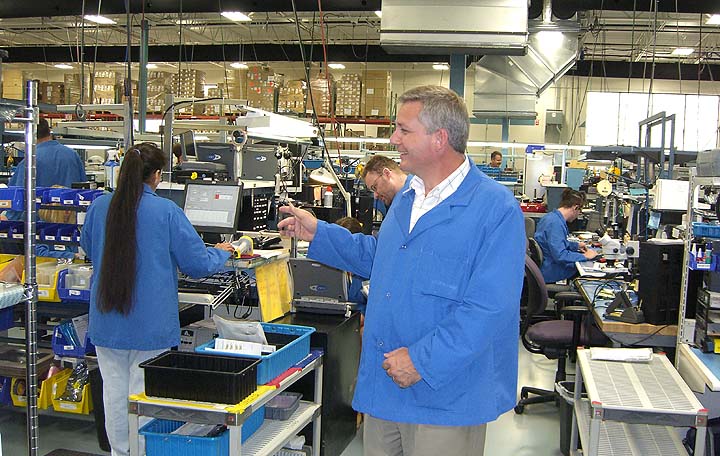
I was given a complete tour of the facility by Brad Telin (see above) who explained all aspects of the operation as well as the thinking behind the layout and organization of the new facility. Just as Henry Ford once revolutionized manufacturing in his Highland and Rouge assembly line plants outside Detroit, innovative companies continue to seek new and better ways to manufacture products. However, while Ford's assembly line produced a paradigm-shifting advance in productivity, it also had a dehumanizing element to it, despite the highly heralded "Five Dollar Day" back in 1914 - more than anyone else paid. Today, Ford-style assembly lines have long since been replaced by friendlier manufacturing and assembly methods, methods that result in optimal productivity and involve people, their ideas and preferences, and how they like to work. (Below: Itronix VP Matt Gerber and RuggedPCReview editor Conrad H. Blickenstorfer during shopfloor tour)
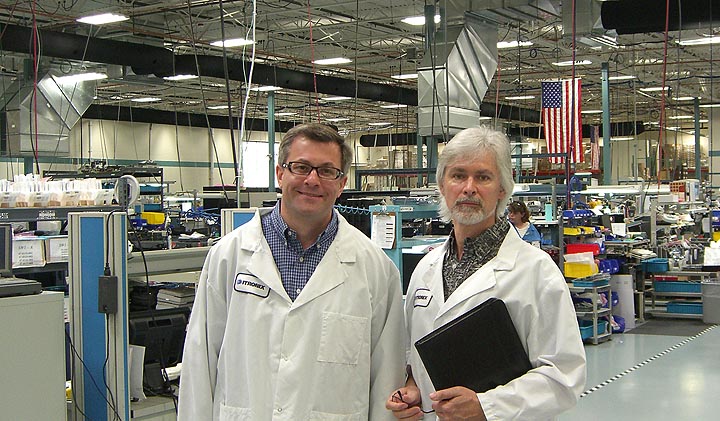
That, of course is not easy. Any which way you look at it, assembling and testing thousands of rugged notebook computers can be tedious, tiring work. Work that requires maximum concentration because, after all, the final product must be flawless and perfect in every respect. The approach Itronix has been taking to ensure both productivity and an optimized working environment for its employees is "Kaizen."
"Kaizen" is a Japanese concept that stands for "continuous improvement" and "change for the better." If that sounds like traditional quality assurance approaches, yes, it includes that, but it is more. Kaizen seeks to eliminate waste - activities, processes, and equipment that costs money but does not add value. Kaizen takes processes apart, analyses them, identifies weaknesses, eliminates rough spots, and then puts the process back together in a better way. Kaizen does not seek to replace people or streamline every aspect regardless of human cost. Instead, Kaizen respects people as the most important part of any process and involves everyone as an active participant. Quite obviously, Kaizen cannot be just a happy-go-lucky free for all. It must be guided by very clear expectations of results, by a clear understanding of the big picture of what is trying to be achieved, and also by a co-operative, inclusive, non-blaming process.
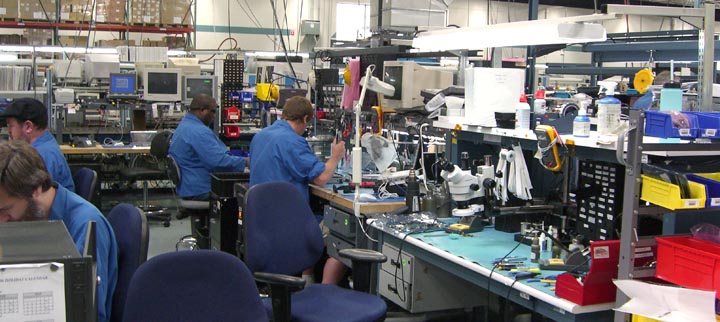
Kaizen can be seen in action on Itronix's shop floor. Compared to their older assembly floor, the new one is smaller and more compact, yet is more productive and produces more machines. Everything is very dense. If you look at a workstation, numerous tools are aligned and positioned so that the worker has easy, ergonomic access. It's all there, plenty of gear and materials, exactly as much as is needed for the job, no more and no less. Itronix makes it a point to visually demonstrate the results of the Kaizen process: whatever is tagged as unneeded during a Kaizen event is carted to a special cell. Staff interested in an item can bid on it and buy it. Whatever is left over is sold off or discarded in an environmentally safe way. The overall result of this continuing process is amazing. People get more done. The overall look and feel is of an incredibly dense organism that works smoothly and efficiently.
Kaizen, however, is not the only concept at work. Operational quality metrics and quality control are everywhere. Manufacturing cycle time, out-of-box audits, system board repair statistics, average hours to build each product, production yields, yields by location, and numerous other metrics are charted and graphed and pinned up on huge boards for all to see. And all are very frequently discussed in meetings. In addition, there are the principles of lean accounting and just-in-time production.
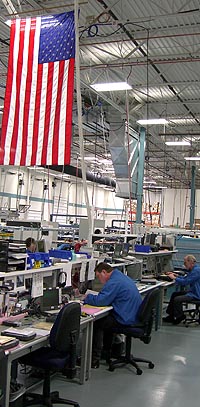 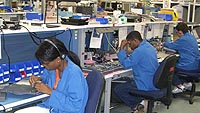 With Kaizen being an ongoing, organic process that has worked out very well for Itronix, the company plans on applying additional methodologies such as Six Sigma, a metric for measuring defects and improving quality. Six Sigma was conceived at Motorola in the 1980s, and has since been adopted by numerous Fortune 500 companies. Itronix is well prepared to apply the methodology, having a qualified "Black Belt" in its management ranks. In six Sigma, a "Black Belt" is an individual certified to apply the technology to projects on a full-time basis.
With Kaizen being an ongoing, organic process that has worked out very well for Itronix, the company plans on applying additional methodologies such as Six Sigma, a metric for measuring defects and improving quality. Six Sigma was conceived at Motorola in the 1980s, and has since been adopted by numerous Fortune 500 companies. Itronix is well prepared to apply the methodology, having a qualified "Black Belt" in its management ranks. In six Sigma, a "Black Belt" is an individual certified to apply the technology to projects on a full-time basis.
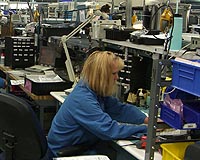 Another challenging task was ISO 9000 certification, the quest for which came with Itronix's pending inclusion into the General Dynamics family. ISO 9000 is a family of standards that requires adherence to consistent business processes. The Itronix Spokane facility was ISO 9001:2000 certified in November of 2005 "for the design and manufacture of wireless rugged mobile computer solutions, wireless integration and implementation services." Another challenging task was ISO 9000 certification, the quest for which came with Itronix's pending inclusion into the General Dynamics family. ISO 9000 is a family of standards that requires adherence to consistent business processes. The Itronix Spokane facility was ISO 9001:2000 certified in November of 2005 "for the design and manufacture of wireless rugged mobile computer solutions, wireless integration and implementation services."
While all those management theory buzzwords may sound academic, walking the Itronix shop floor shows it all in action. Nothing seems out of place. Things are dense, but not cluttered. Technology is used to help workers, not replace them or impose on them. Whatever can be done better is done better. Take all the different certification labels, for example. Each machine being created needs a number of them depending on where it goes, what it contains, and what its purpose is. Since each part is tagged and scanned, knowing what each unit contains is easy, as is printing a sheet that shows all the labels and where they go. And each machine also has a template workers can use to align things right. That same process of tracking each item is used in a final check of the already boxed-up computer. The box is weighed and its exact weight, down to the last fraction of an ounce, reveals if the proper parts are included. Other aspects are entirely manual. One job is to test the customer experience. Grab a box, unpack it piece by piece, make sure everything is there, make sure it all makes sense.
Another impression is the exceptional diversity in the work force. Young and old, male and female, all sorts of ethnic backgrounds, clean-cut to tattoos and body art, it's all there. People working together in this high-tech, highly optimized organic shop floor. And above it all hangs a huge American flag.
The "Torture Chamber"
No matter how carefully designed and manufactured a rugged computer is, before it is released into the field it must be tested, tested again, and then tested again. There are third party testing labs, such as the Southwest Research Institute, that run rugged machinery through whatever tests and certifications are required. However, companies like Itronix also have their own labs where equipment can be tortured and tested for weaknesses, or to find the true limits of its endurance. Each "torture chamber" I've seen is a bit different, but they all have equipment designed to determine the operating temperature range; ability to resist and survive shock and vibration; exercise notebook hinges, keyboards, digitizers, and contacts; determine waterproofing, and more.
The pictures below show just a few tests that Itronix and Tadpole machines must go through before they are declared fit for delivery to customers.
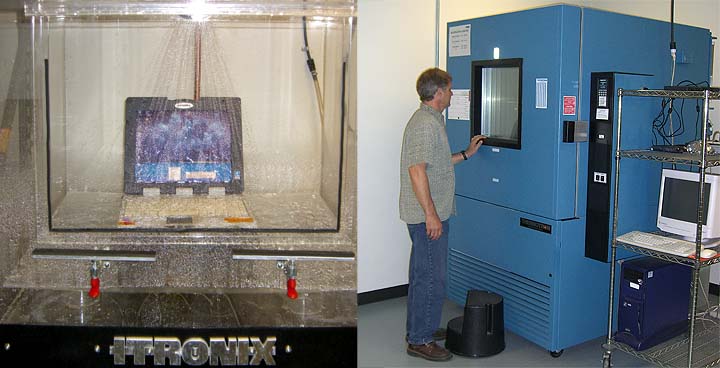
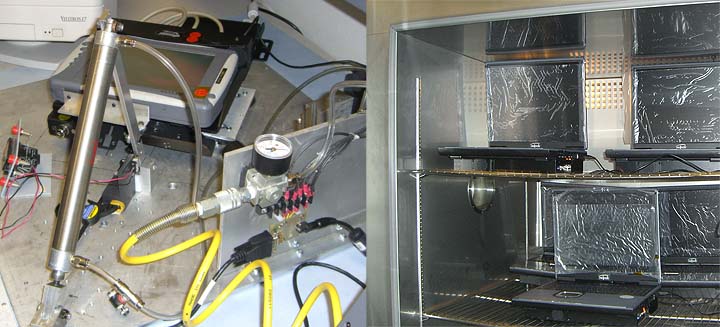
The Tadpole side of the business
Longtime readers of Pen Computing Magazine may remember the occasional coverage of Tadpole, a company that started life in 1983 in the UK. In the mid and late 1980s, there was much excitement about moving to Unix, and with that came efforts to provide Unix not just in large workstations and servers, but also in small packages. So Tadpole tried to create Unix-based notebooks. Those never became mainstream products, but were pretty successful in government, for Unix demonstrations, and in some vertical markets. At some point Tadpole ran Unix on Telxon (later acquired by Symbol Technologies) 1192 pen computers and used them as Java tablets.
The company was doing well until the late 1990s, but was hard hit by the technology downturn in 2000/2001. There was a management change and Tadpole split into a hardware and a software side. In recent years business predominantly came from government, roughly 80% of the business, which appreciates the stability and security of the Sun Microsystems Solaris platform. The life cycle of Unix applications is generally a lot longer than that of Windows apps, and so there are numerous older systems and applications that remain in active, productive use. One value proposition of Tadpole is to support all those older governmental applications. In all likelihood, the Federal Government will continue to use Solaris, with Trusted Solaris probably being the securest OS on the planet. As a result it is used for mission-critical applications where servers cannot afford to be down. Tadpole's product development roadmap is therefore geared towards military/government.
In September of 2005, Tadpole, which had been working with General Dynamics for a long time, became a GD company and its products are now marketed, serviced and sold through Itronix.
The challenge ahead for Tadpole is the design and positioning of its next generation products. Most Sun's SPARC processors are really for large servers. The "Niagara" multi-core SPARC processor with 8 cores is a lower-cost solution, but its single floating point processor makes it more suitable for certain applications than for others. Another possibility is the highly regarded AMD Optron CPU.
Tadpole also offers thin clients. The definition of a "thin client" is somewhat vague, but generally refers to a device - desktop or notebook - that has no local storage or processing power. Instead, it connects to a server and has just enough smarts to run even complex applications on its display. As a result, sessions can be started and then continued on another computer. And since there is no local storage, everything is totally secure and nothing can be stolen or copied. Devices are protected by SmartCards. Insert the card and you can start or pick up a session. Administration is much simplified compared to conventional networks, and there may be additional cost savings due to software licensing and so on. Just a few staff can handle a large number of users. While others have put forth their own thin clients/network computers/webpads, Sun's Sun Ray concept, championed by then CEO Scott McNealy, is perhaps the purest thin client implementation, essentially consisting of a flat panel display with smartcard reader access. Tadpole packaged Sun Ray technology into notebooks based on high quality Compal laptop designs.
Tadpole veteran David Miles demonstrated the use of an Itronix Sun Ray-based thin client. At this point, Sun Ray clients depend on a standard wired or wireless Ethernet. They do not have a browser and thus cannot log into a WiFi network hotspot such as one might find at a Starbucks. The next generation will include a microbrowser and possibly 3G networking support so that users can log on in more locations/settings.
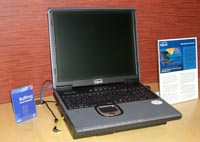 I asked Miles why earlier webpad/Network Computer efforts and initiatives weren't successful and his answer was that the required networking infrastructure just wasn't there in most places, and that servers were not up to the task. The network component has been solved now, and the server component as well. According to Miles, IDC now projects a 40+% annual increase in thin clients over the next few years, resulting in a billion dollar opportunity in thin clients within the next five years. IDC further speculates that 15% of all desktops may soon be thin clients. I asked Miles why earlier webpad/Network Computer efforts and initiatives weren't successful and his answer was that the required networking infrastructure just wasn't there in most places, and that servers were not up to the task. The network component has been solved now, and the server component as well. According to Miles, IDC now projects a 40+% annual increase in thin clients over the next few years, resulting in a billion dollar opportunity in thin clients within the next five years. IDC further speculates that 15% of all desktops may soon be thin clients.
Itronix's Tadpole's product lineup is very broad. The Bullfrog models (shown in the picture on the right) are large, heavy notebooks in the 20 pound range that run UltraSPARC III processors. The SPARCBook, Viper and SPARCLE look like standard notebooks and weigh no more than one. On the ultra-thin client side, Itronix offers the Comet 12 (3.15 pounds) and Comet 15 (5 pounds), very light and handy clamshells that are clients to Sun Ray servers. The Comets can be used with FIPS 140-2 security from Fortress Technologies, providing 256-bit AES encryption.
Itronix product updates
Itronix Duo-Touch tablet and handhelds
 Tim Talda, director of product line management for tablets and handhelds, presented an update on the Itronix GoBook Duo-Touch Tablet PC slate which is still the smallest rugged Tablet PC available. There is substantial interest and activity in Europe for this unit that can accommodate up to four radios in the same unit. The unit's current IP54 sealing may increase, and Itronix is going for four-foot drop certification. Always well connected, the Duo-Touch now supports EDGE, EV-DO, 3G UMTS (Europe), and also offers connection for external radios. The entire machine was designed and engineered to be able to handle temperature extremes. And the company did not stop with just the computer itself in their ruggedization efforts. Even the Wacom stylus is sealed and rated to IP54 specifications. The hard drive heater heats the spindle, to warm up the grease, and there are heatsinks and shields designed to improve radio performance as well. Achieving all those different kinds of shielding in same unit was a major task. Tim Talda, director of product line management for tablets and handhelds, presented an update on the Itronix GoBook Duo-Touch Tablet PC slate which is still the smallest rugged Tablet PC available. There is substantial interest and activity in Europe for this unit that can accommodate up to four radios in the same unit. The unit's current IP54 sealing may increase, and Itronix is going for four-foot drop certification. Always well connected, the Duo-Touch now supports EDGE, EV-DO, 3G UMTS (Europe), and also offers connection for external radios. The entire machine was designed and engineered to be able to handle temperature extremes. And the company did not stop with just the computer itself in their ruggedization efforts. Even the Wacom stylus is sealed and rated to IP54 specifications. The hard drive heater heats the spindle, to warm up the grease, and there are heatsinks and shields designed to improve radio performance as well. Achieving all those different kinds of shielding in same unit was a major task.
Talda described the trend towards adherence to the RoHS (Reduction of Hazardous Substances) schedule. RoHS is a very tough European regulation that requires elimination of certain heavy metals and fire retardants, and so on. This can have far-reaching implications that may affect virtually every part of a device. For example, even the soldering process with lead-free solder is 30 degrees higher, which means numerous changes to the production process as well as the choice of components.
The Duo-Touch received minor upgrades such as a larger 80GB disk, Haz Loc Class 1 Div 2, and a variety of different radios. Also optionally available is 802.11a/b/g WiFi.
The image below shows a Duo-Touch computer's digitizer/LCD assembly being exercised by a specially designed machine that performs a variety of operations thousands of times.
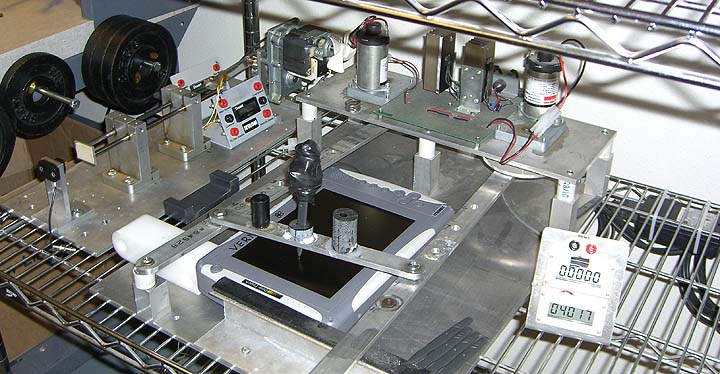
Itronix Q200:
The Itronix Q200 is an ultra-rugged flashlight-style computer that sports an incredible IP67 rating. It was initially designed primarily for meter readers, but quickly saw duty in many other vertical and industrial applications. Built around a 400MHz Intel PXA255 processor, the Q200 may well be the most rugged handheld in its class.
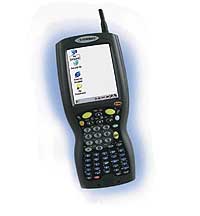 Itronix's Tim Talda related a story, documented by conclusive video footage, of how they had picked a Q200 off the assembly line with the intent to see just how much the device could really take. They placed the computer on a balcony on the second floor of the building and then dropped it onto the concrete walkway below--a 15 foot drop. The concrete was chipped, but the Q200 was none the worse for wear and started right up. Itronix's Tim Talda related a story, documented by conclusive video footage, of how they had picked a Q200 off the assembly line with the intent to see just how much the device could really take. They placed the computer on a balcony on the second floor of the building and then dropped it onto the concrete walkway below--a 15 foot drop. The concrete was chipped, but the Q200 was none the worse for wear and started right up.
Apparently in an adventurous mood, they took the handheld back up to the second floor balcony, held it up high and again let it fall to the concrete below--a 21 foot drop. Some scratches on the device, but it started right up and everything worked fine, even the radios.
For a final test they slowly ran a 7,500 pound Ford truck over it. The screen survived undamaged, but now the Q200 no longer booted. The reason was that the battery had been compressed and stopped working. Talda inserted a new battery and the Q200 was fine, and continues to serve as a demo unit to this day. If something were to go wrong, the iRescue automated data and application restore utility makes sure nothing gets lost, ever. I must say, this was perhaps the most entertaining story about mobile computer ruggedness. The video showed it was all true, and I wouldn't have any doubt anyway. No one would, of course, abuse an expensive piece of equipment this way on purpose, but it is definitely good to know that it can survive such incredible punishment.
Itronix has been updating the Q200, like all of its other products. Units are now available with Windows Mobile 5.0 and also CE.Net 5.0. Internal WiFi now supports 802.11b and g. UMTS/HSDPA radios are available. And the unit will shortly be RoHS compliant.
iCare Service Programs
All technology needs service every now and then, and sometimes computers do break. Especially when they are used in extreme situations, such as many Itronix devices encounter daily. As a result, Itronix takes service, which also represents about 20% of total revenue, very seriously. "Our iCare system is based on a Total Cost of Ownership model," explained Robert Howells, VP, Service Solutions. "Our goal is to both increase user productivity and lower TOC."
iCare is a complete suite of services that provide an end-to-end solution for customers. 95% of all hardware service is done in Itronix's state-of-the-art Spokane facility. There are also service center ins in the UK (Coventry) and in Canada. Specially certified Authorized Service Providers perform repair and warranty service in other parts of the world. "We developed a concept of asset maximization services with the goal of keeping a customer's device in useful service as long as possible," says Howells and explained the various service programs and levels--Ruby, Emerald, Diamond, and Sapphire. Once a device has reached the end of its useful life, Itronix offers a trade-in/asset disposal program.
Service, however, doesn't stop at repairing equipment. There is also increasing emphasis on system integration, project management, training, Gold Disk imaging, installation, configuration, and a highly specialized Tier I Help Desk.
On the wireless side, Itronix helps customers by offering carrier service activation, mobility management software, and wireless consulting.
Finally, Itronix has a number of software solutions for vertical markets where they do application integration. Examples are their field force automation software and software management systems. In addition, Itronix may team up with one or several partners, such as Dextera in Seattle.
No part of Itronix ever seems to stand still, and that goes for the service organization as well. There are plans for offering much more elaborate integration services: A new group is being established whose mission it is to identify third party products that work with and complement Itronix products, thus adding to overall customer satisfaction. Howells feels that, in addition to increasing revenue, such a service may help closing deals that might otherwise not close.
Service and maintenance are not the glamour parts of any manufacturer. Trust and customer satisfaction must be earned over time, and conflicts may be encountered. Howells seems the ideal man for the job. I have rarely met an individual who so totally believes in the value of customer service and who is totally dedicated to it. After his detailed presentation where he repeatedly stressed the need to assist and help customers during the entire life cycle of a system or a product, he closed by saying, "I feel this in my heart."
What else could one want?
Overall Impression
Companies are being bought and sold all the time. It's in the nature of business. When it involves an entity in a field you follow -- as we follow rugged and mobile computing -- you tend to get concerned. Not all acquisitions are made for the right reason. Sometimes a war between competitors ends up in one swallowing the other, just to annihilate and dismantle it. Sometimes once proud companies fall on hard times and get absorbed by lesser entities, which then get absorbed themselves. A prime example is Digital Equipment Corporation that was sold to Compaq which was then sold to Hewlett Packard. Is the world better off without an independent DEC and Compaq? It is not. Fortunately, things are very different with Itronix.
First of all, everyone knew a sale was eventually going to happen. Equity investment firm Golden Gate Captital had purchased Itronix in 2003 from former parent Acterna with the intent of prepping Itronix for a sale. Within just two years, Itronix prospered enough to make it a lucrative proposition for General Dynamics, a huge conglomerate that views Itronix as a valuable complement to its business and thus will make resources available that Itronix never had before. The sheer mention of the name "General Dynamics" will open doors. If there is one concern, it is that some commercial customers may be less comfortable dealing with what is generally known as a military/defense contractor than with an independent computer company.
The new Spokane facility is both state-of-the-art and very employee-friendly. And having the entire organization in one building makes perfect sense. The introduction of the GoBook XR-1 provides Itronix with a class-leading high-end rugged machine, and the rest of the lineup is up-to-date. Something else impressed me, and that is the drive and enthusiasm of everyone working there. There is a sense of passion for the job and the products that is rarely found these days. Product managers who actually know every aspect of their product. Engineers who proudly demonstrate their tricks. Managers and executives with passionate visions. Shopfloor workers always seeking ways to do an even better job. It's quite impressive.
It will be interesting to see how the Tadpole products will be integrated, and what additional offerings Itronix will present in the near and intermediate future.
By Conrad H. Blickenstorfer
|






